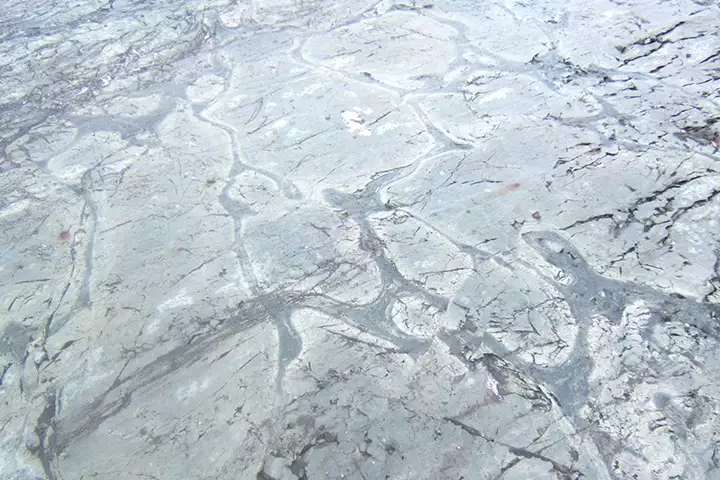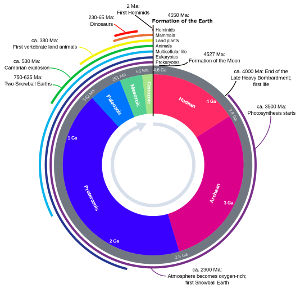The Archean Eon

Weathered pillow lava in the Temagami Greenstone Belt of the Canadian Shield
Dated at 2.7 billion years old
The Archean Eon stretched across time from 4 billion years ago to 2.5 billion years ago, spanning the time between the Hadean and the Proterozoic Eons. The Archean began during the Late Heavy Bombardment, a time when planetary orbital shifts throughout the solar system was causing planetesimals in eccentric orbits to collide with the rocky inner planets. Most evidence for the bombardment is derived from the surfaces of the Moon and Mercury as the surfaces of both have changed little since that time. On Earth most physical evidence of the bombardment has been wiped clean in the ongoing volcanic and plate tectonic action.
The Earth had formed a crust and mantle during the Hadean but that surface was in constant volcanic churn, forming and reforming itself again and again during the Late Heavy Bombardment. Hints of life have been found and dated to the late Hadean. Surviving the planet-wide bombardment required that life to hover at the bottom of ancient seas. The seas from that time were hot, 230°C, but they didn't "boil" because of the crushing weight of the dense carbon-dioxide atmosphere. The water was also acidic due to the high concentration of carbon-dioxide in it.
Eras of the Archean Eon
- Eoarchean Era
- Paleoarchean Era
- Mesoarchean Era
- Neoarchean Era
Fossil records dated to 3.5 billion years ago show evidence of stromatolites, constructions built by colonies of cyanobacteria working together to provide their species with safe havens from the surrounding environmental changes. The growth of stromatolites increased across the surface of the planet until it peaked around 1.25 billion years ago. By the beginning of the Cambrian stromatolites had been reduced to about 20% of their former "empire" and that percentage has declined steadily since, except for immediately after two major extinction events: the Permian-Triassic and the Jurassic. It's speculated that the decline of stromatolites began with the rise of "grazers" (creatures complex enough to enjoy grazing on the prokaryotic organisms that created the stromatolites). Even today, stromatolites occur only in areas toxic to most other Earthly life: inside volcanic vents, near hydrothermal vents at the bottom of the ocean, in highly alkaline and highly acidic environments in fresh water, in caves with highly mineralized water and in areas of ocean water with high saline concentrations. It was that early cyanobacteria that began the conversion of the Earth's atmosphere from the highly acidic carbon-dioxide/nitrogen/sulfuric morass it was to the oxygen/nitrogen mix it is today.
The Archean was a time of high tectonic plate and volcanic activity. Geologically, rock that was on the surface during the Archean is estimated to comprise only about 7% of the surface rock on Earth today. Allowing for erosion and destruction of past formations, it's estimated that the surface land mass of the Archean Eon varied between 5% and 40% of today's surface land mass. The recycling of the Earth's surface was a very efficient process. At the same time, as the planet's interior cooled, protocontinents came and went, then cratons began to form in what we now know as western Australia, the Canadian Shield, Greenland, Scotland, the Baltic Shield, southern Africa, Brazil and India. On most of those cratons the rocks found today are often highly metamorphised deep-water sediments. Carbonate rocks are rare among the mudstones, volcanic sediments, banded iron formations and graywackes, indicating the oceans were high in dissolved carbon dioxide and relatively acidic. Greenstone belts comprised of alternating layers of metamorphised igneous and sedimentary rock were common along the lines of intersection between protocontinents.
Today's Canadian Shield contains the largest amount of exposed Archean rock on Earth. The heart of the Shield began to grow from the sea bottom more than 3.9 billion years ago. It pushed above the waves about 3 billion years ago and has remained above sea level most of the time since. Geologic evidence points to accretion of materials around the core of the Shield until it stretched from Texas and the Yucatan north to the western cordillera, then east across Canada and into Greenland with a finger dropping south into the Adirondacks of New York. But much of those materials were overlain during continental shelf submersions and, generally speaking, the further they are located from the surface Archean rock, the deeper they tend to be buried under those surface accumulations. Back in those days the Canadian Shield was covered in high, jagged peaks but after all those years of erosion and continuing uplift, today's landscape consists mostly of rolling hills that vary between 600 feet and 2,000 feet above sea level.
The Archean ended with the beginning of the Oxygen Catastrophe.

The Canadian Shield (the red and purple parts of the image),
Archean rock, what remains of the Laurentia Craton on the surface of the Earth's crust
Geologic Clock and bottom map are in the public domain
